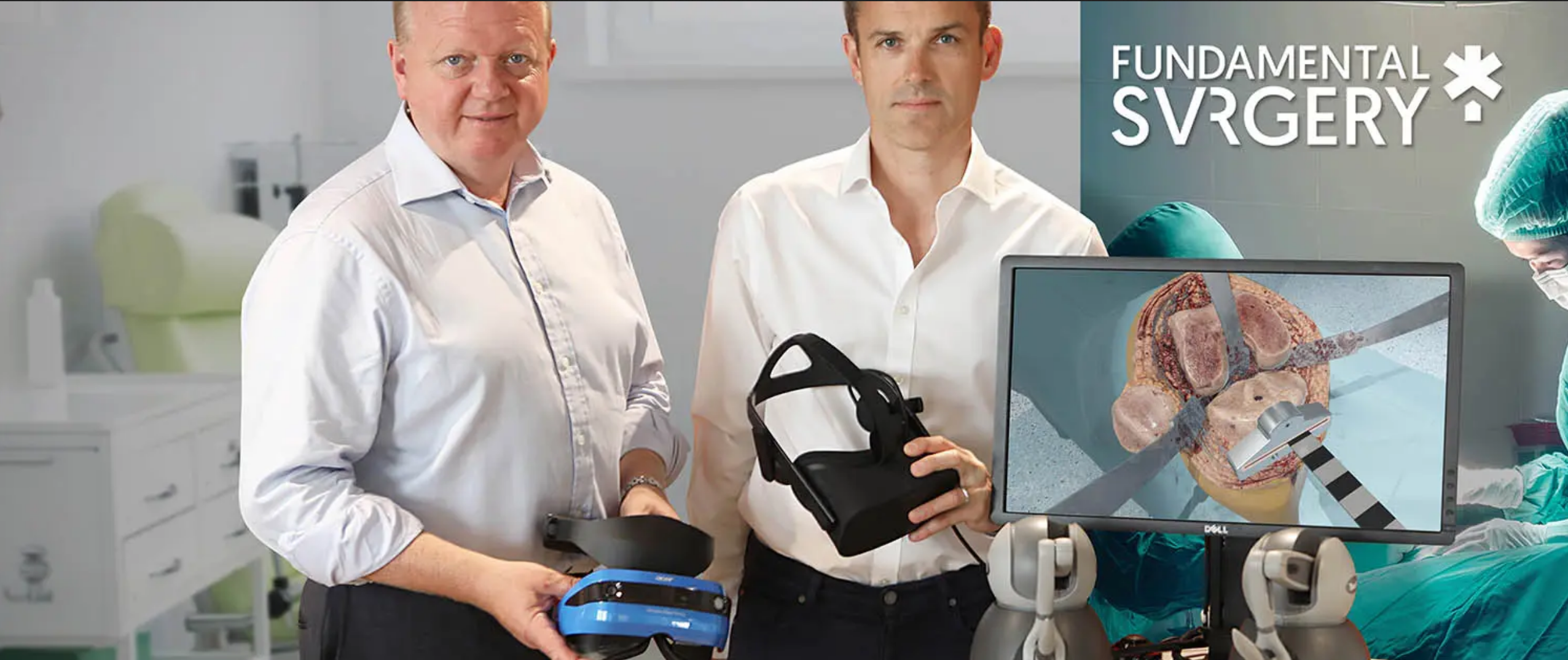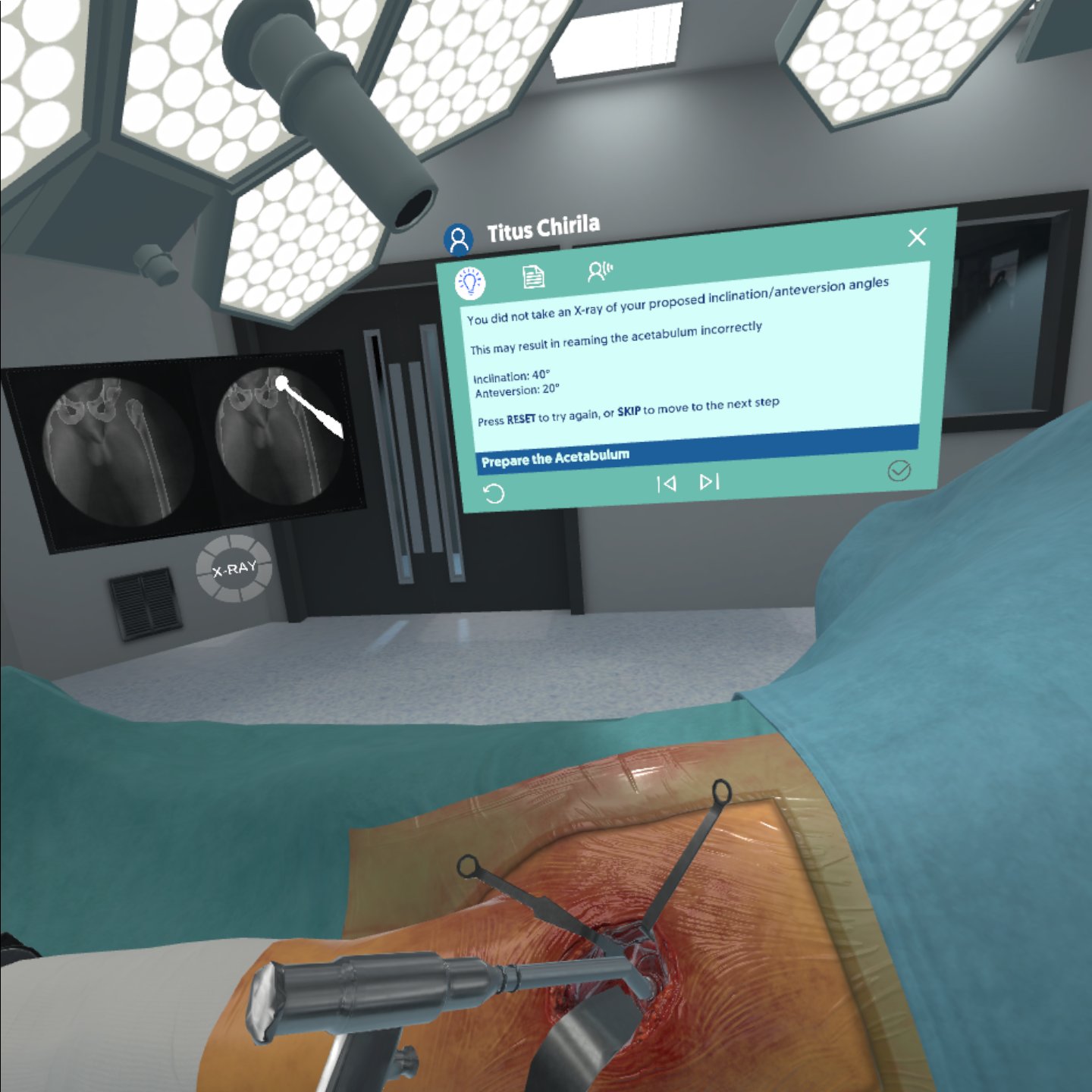Technologists and entrepreneurs Richard Vincent and Chris Scattergood were part of the mobile phone market for decades, creating innovative businesses with disruptive technologies. Then, in 2014, they decided to reimagine how emerging virtual reality (VR) systems could revolutionize the medical industry. Six years later, their company, FundamentalVR, is using the founders’ patented Haptic Intelligence Engine software to deliver a realistic 3D platform for simulating surgical procedures. The tool helps educate and train healthcare professionals, so that they can refine skills in a safe and repeatable ecosystem that is also highly measurable.
By relying on a global panel of medical experts, the co-founders claim to have created a unique surgical simulation immersive experience called Fundamental Surgery, which combines their software with low cost, readily available technology, and machine learning to offer easy access to procedures for medical trainees and professionals. 3D virtual experiences can provide more benefits versus traditional training modalities that have been around for hundreds of years, such as cadaver use, a very expensive and not always practical method that is rarely accessible.

Richard Vincent and Chris Scattergood at FundamentalVR headquarters in London. (Image courtesy of FundamentalVR)
Many medical schools are turning to VR instead of dissection, especially brand-new medical programs that have neither the tradition nor the million-dollar facilities required for cadaver dissection. In fact, simulation systems have proven to help many medical fields overcome cadaver shortage and costs. In the US alone, researchers estimate that fewer than 20,000 Americans donate their bodies to medical research and training each year, which is barely enough to cover the needs of 21,622 first-year matriculation students who have to dissect cadavers, surgeons that need to develop new procedures without risking lives, pharmaceutical companies that use them to test drugs, and forensic specialists who seek to understand how corpses decompose over time.
But there is still a big market for dead bodies and so-called body broker companies that dissect them and sell the parts for profit in a largely unregulated US national market. This comes as many surgeons continue to describe the tactile experience of synthetic cadavers or computer simulations as unable to replicate the experience of practicing on human body parts. Yet current advances in 3D technologies are garnering support from surgeons worldwide, as companies like FundamentalVR continue to disrupt the field, offering realistic training experiences for surgeons to hone their skills anywhere at any time for the cost of just one cadaver.
Academic institutions like the Mayo Clinic, University of California Los Angeles (UCLA), Sana Hospital Group in Germany, and University College London Hospitals (UCLH) and St. George’s Hospital in the UK, are taking in the benefits of FundamentalVR’s platform. For example, New York University is using it to assess newly qualified medical school graduates as part of their rotation period to determine whether they have the aptitude to move onto their residence programs to become orthopedic surgeons.

Training for medical procedures from home with FundamentalVR’s haptics-based platform. (Image courtesy of FundamentalVR)
“Today more than ever, people are recognizing the importance of new training methods. Due to the COVID-19 pandemic, all of the traditional training modalities have stopped, so suddenly VR and what it can do for learning and to refine skills could change the paradigm of medical training across the world,” said Vincent during an interview with 3DPrint.com. “Anyone in the medical field will tell you that one of the biggest frustrations is trying to get access to the experts. So, the great thing about our system is that we capture their knowledge and digitize it so that others can access it at any time, guiding users and recording everything that happens during the virtual session. Then, it plays it back so that experts can review it and focus on the most critical challenges and limitations that the user faced, aiming to improve them during other simulation sessions.”
Named as one of the best inventions of 2018 by Time magazine, the Fundamental Surgery platform was launched in August 2018. By combining VR with cutting-edge haptics, the founders believe they have created a scalable “flight simulator” experience for trainee and qualified surgeons, allowing them to experience and navigate the same visuals, sounds, and feelings they would during a real surgical procedure. Its multimodal platform with multi-user capability allows unlimited users to practice, learn, and teach together inside an operating room (OR).
Primarily focused on orthopedic and ophthalmological procedures, the company has big plans for the future, including adding more surgical disciplines, such as robotic and neurosurgery, and continue work with leading pharmaceutical companies to combine virtual and mixed reality with haptic feedback using the FeelRealVR platform to create simulated surgical procedures that help educate and train healthcare professionals.
Designed to be compatible with any laptop, VR headset, or haptic device enables the platform to be delivered at a competitive cost. Vincent described working with standard, off-the-shelf hardware so that the cost of the equipment – including all the haptics – is less than $10,000. Furthermore, its remote data analytics and data dashboard covering surgical skills and knowledge provide invaluable insight into surgical capability and education progression.
Although the company has come a long way since Vincent and Scattergood first decided to create a healthcare business at the intersection of immersive technology and haptics, the duo faced a few challenges during the development of their surgery simulation platform. Vincent suggested that they spent a great deal of time developing their haptics technology because they needed to recreate the required sense of touch surgeons need to virtually operate. Eventually, they found a way to enable enough of a sense of touch for surgeons to simply close their eyes and be able to feel a bone or a tissue. Other technical challenges included optimizing the graphics card for a better visual experience and designing the procedures with the experts.
“To design the procedures, we film hour-long operations, then we start to deconstruct them, down to every minute, so that we can then recreate the procedure for our users. Our panel of experts is constantly recording in the operating theatre for us, sending us procedures that we then make available via our Fundamental Surgery subscription model, such as the total knee anthroplasty or spinal pedicle screw,” explained Vincent.
All Fundamental Surgery simulations have received accreditation from the Royal College of Surgeons of England, being recognized as activities for surgeons to maintain professional development ratings, contributing to surgeons Continuing Professional Development (CPD) points, as well as by the American Academy of Orthopaedic Surgeons for Continuing Medical Education (CME) points.
In the future, FundamentalVR plans to continue adding more surgical disciplines and have workflows similar to those used in 3D printing systems, taking Diacom images to create customized VR models for patients and allowing surgeons to rehearse a procedure in the VR platform as many times as they need to. Since the platform measures everything users do, from head movements to patient outcomes, the company is also planning to tap into that data, which could provide real insight into capability and risk. This could be valuable for healthcare providers, the life science industries, and insurance companies. According to Vincent, this would be a great step forward, since any measurable data that is available today only focuses on the length of a procedure and whether the patient had to be readmitted due to a post-op problem.
“Over the last three years, there has been a recognition and a move towards this technology, but I think that now, due to the COVID-19 pandemic, it has gone from an interesting innovation to a critical one,” described Vincent. “Nobody in the medical industry now doubts the role of virtual reality as a way of going forward. The same way flight simulation has improved safety in aviation in the last 20 years, we believe our surgical simulator will change the way medical professionals learn and are assessed.”
Subscribe to Our Email Newsletter
Stay up-to-date on all the latest news from the 3D printing industry and receive information and offers from third party vendors.
Print Services
Upload your 3D Models and get them printed quickly and efficiently.
You May Also Like
Reinventing Reindustrialization: Why NAVWAR Project Manager Spencer Koroly Invented a Made-in-America 3D Printer
It has become virtually impossible to regularly follow additive manufacturing (AM) industry news and not stumble across the term “defense industrial base” (DIB), a concept encompassing all the many diverse...
Inside The Barnes Global Advisors’ Vision for a Stronger AM Ecosystem
As additive manufacturing (AM) continues to revolutionize the industrial landscape, Pittsburgh-based consultancy The Barnes Global Advisors (TBGA) is helping shape what that future looks like. As the largest independent AM...
Ruggedized: How USMC Innovation Officer Matt Pine Navigates 3D Printing in the Military
Disclaimer: Matt Pine’s views are not the views of the Department of Defense nor the U.S. Marine Corps Throughout this decade thus far, the military’s adoption of additive manufacturing (AM)...
U.S. Congress Calls Out 3D Printing in Proposal for Commercial Reserve Manufacturing Network
Last week, the U.S. House of Representatives’ Appropriations Committee moved the FY 2026 defense bill forward to the House floor. Included in the legislation is a $131 million proposal for...


































